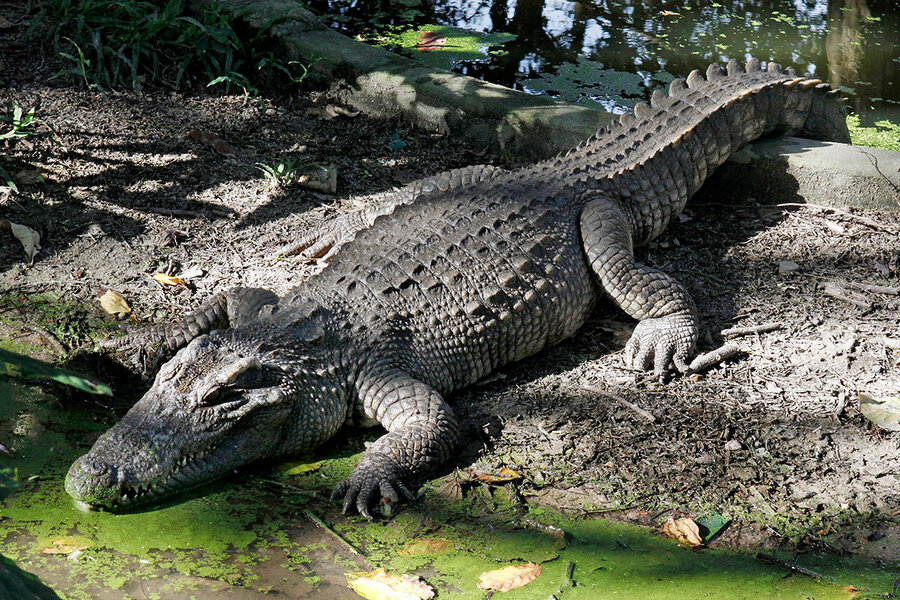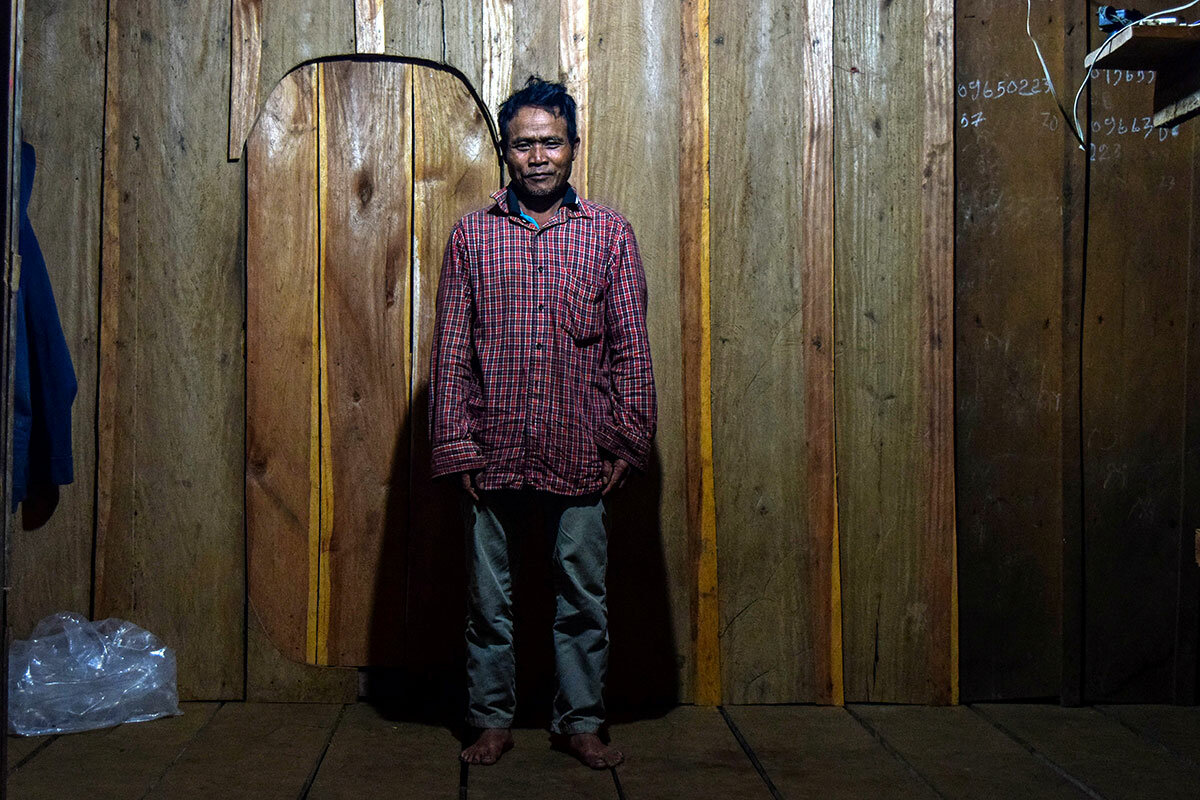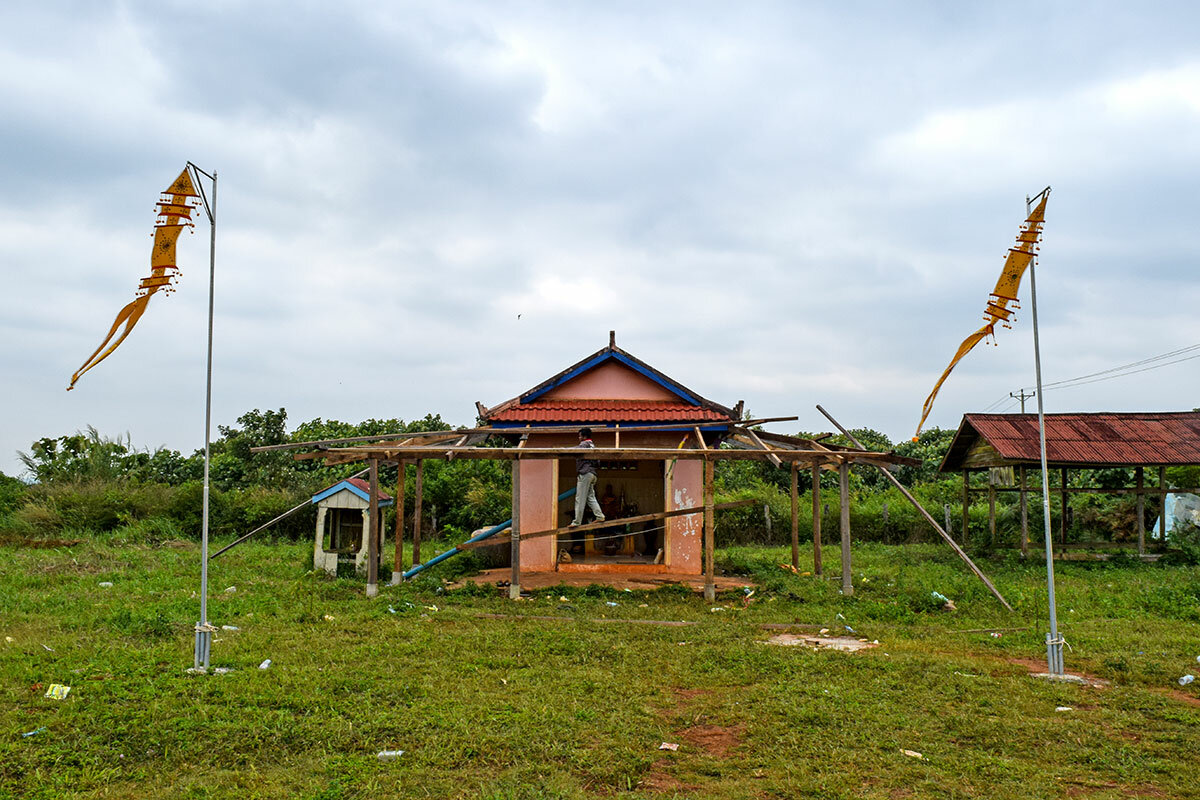In a threatened Cambodian forest, hand-in-hand push to protect land and people
Loading...
| Phnom Kravanh commune, Cambodia
For the Chong people of Cambodia, Siamese crocodiles are revered, respected, and left alone.
But several times a month, Put Poeurn goes looking for them.
Wearing the everyday clothes of rural Cambodia – old jeans, faded collared shirt, and sandals – plus a GPS and machete, he ventures through forest rivers to investigate signs of illegal hunting. This time of year, amid the six-month rainy season, “it is much harder to walk around the area where they live, as the water is deeper and the plants higher,” says Mr. Put Poeurn. But even when checking crocodile nests, he’s not scared: thanks to his yearly offering at a forest shrine, he says, the crocodiles will leave him be.
Put Poeurn is one of the wardens at the frontline of efforts to ensure that human activity does not disturb the critically endangered crocodiles, a job he took over from his father four years ago. Rampant deforestation and development have increased pressure on animals throughout Cambodia. They’ve especially intensified in the country’s “spirit forests,” as the hill communities like the ethnic-minority Chong call them, which are some of the creatures’ last refuges. But the changes also threaten their culture, as the landscape that’s sustained them for centuries transforms and draws more outsiders to the region.
If the disappearance of the forest has tied the Chong’s and the crocodiles’ futures closer together, however, they may be able to use that connection for good. New, nongovernmental organization-led initiatives to protect the animals’ habitat provide ecotourism jobs and other financial support, which could boost the Chong’s chances to determine their future.
“I am proud to be Chong and living here in this historic area, preserving the crocodiles for the next generation,” says Put Poeurn.
Disappearing forests
O Soam, the collection of villages where Put Poeurn lives, is nestled in the remote Cardamom Mountains, a dense, biodiverse swath of forest on the Cambodia-Thai border that is home to 2,000-year-old rock paintings. Two hundred Chong families live around O Soam – as do an estimated 50 of Cambodia’s 200 krapeu phnom, or mountain crocodiles. Globally, there are likely fewer than 1,000 left, all in isolated pockets across Southeast Asia.
Cambodia’s deforestation rate is among the fastest in the world, thanks to a mix of population growth, lax law enforcement, and illegal logging driven in part by rural poverty. As habitat loss accelerates, so does poaching. Once-endemic tigers are now believed to be extinct, and leopards likely to follow.
“I am very proud that the Chong have protected the crocodiles, and it makes me angry that others have killed them,” says Hun Tang, a retired farmer. “We have always been Buddhist, but also with a strong belief in spirit forests and nature. But these beliefs are weakening. Before, no one would cut the trees. Just look around and you can see this is no longer true,” he says, waving at the pepper, banana, and pineapple plantations now flourishing where forest stood five years ago.
“A lot of this is done by Khmer, but some Chong also,” he sighs. Poorer members of the community typically make less than a dollar per day, while a single hardwood tree, once chopped down, can fetch hundreds of dollars.
Chinese-funded hydroelectric projects are increasingly reaching once-remote locations, adding further pressure to the sensitive habitats. There are at least six dams on waterways around O Soam, which have flooded some spirit forests, but have also brought jobs, electricity, and increased access to the outside world.
As new opportunities emerge, old ones may disappear – including environmentally sustainable livelihoods. Put Poeurn, for example, is one of eight Chong residents paid by the conservation group Flora and Fauna International (FFI) to monitor the crocodiles. But he also farms rice, and travels far into the surrounding area searching for resin trees, whose collected sap is used to make varnish, to waterproof boats, and as a cheap fuel. Others sell cardamom and honey, both alternatives to the timber industry. Such trees used to be more easily found in O Soam’s spirit forests, but as they vanish, so does this source of income.
Caught amid change
Those economic changes are entwined with cultural ones, as well.
“The community faces a number of threats to its cultural identity,” says Eam Sam Un, a senior biologist at FFI’s Flagship Species Program. Key among those is the destruction of spirit forests. For generations, Chong people have made biannual offerings here, leaving food and drink in return for spiritual protection – and a sign of respect for the environment in which they lived, foraged, and hunted.
The loss of spirit forests “may shake the basis of their identity,” says Hiroyuki Ishibashi, a researcher at the Research Institute for Humanity and Nature in Japan who studies communities in the Cardamom Mountains. Losing forestland also means losing a “place where people can recall and tell stories to others about their ancestors and historical experiences.”
Forty years ago, there were 100 Chong families in the area, and no one else, according to Sok Boeurn, the newly elected chief of several villages. Now there are almost 800 families total, and only a quarter are Chong. They have largely lost their distinct language, with only a few words differing from the old-fashioned, long-isolated Khmer they use everyday.
Like many older Chong in O Soam, Mr. Sok Boeurn blames some of the changes on Cambodia’s many years of conflict and disruption death and disruption under Pol Pot’s genocidal regime in the 1970s.
“I remember the ladies used to wear high-necked dresses.... But all that changed with the Khmer Rouge, and now we wear the same as everyone else,” he says, sitting on a plastic chair in his 3-room wooden office, dressed in a blue collared shirt and worn grey suit pants.
“I would prefer we didn’t lose our identity, but of course it is up to the people. I do my best to protect our culture and traditions,” says Sok Boeurn.
'Many more years to come'
Working hand-in-hand with environmental non-governmental organizations, however, some Chong hope they can build a more secure future for the forest and themselves.
In the Areng Valley in the southern Cardamom Mountains, the group Mother Nature has spent years working with the Chong community to prevent illegal logging, and blocked off a hydroelectric dam project after winning public support. And FFI’s crocodile-warden project, now going on 17 years, is just one of its activities in the region. The group is also working to identify distinct crocodile populations and relocate at-risk animals – not only to save individuals, but to boost the genetic diversity of the remaining, isolated communities.
“By working with the Chong and local populations, we are confident that O Soam’s crocodiles will enjoy protection for many more years to come,” Mr. Sam Un says. FFI’s approach goes to the roots of deforestation, working with O Soam residents to boost food security and more sustainable, forest-friendly income to diminish logging’s appeal. Indigenous communities’ livelihoods have been improving as they deepen their engagement with its programs, he adds.
The forest destruction is hard to miss, but the Chong stories about crocodile spirits have struck a chord with new, non-Chong arrivals. At a moon-lit barbeque to celebrate the annual Water Festival, Khmer residents swap tales of what’s befallen people who touch them or their nests.
“The crocodiles are special, and we should leave them alone,” one reveler warns the others.
Lifelong O Soam resident Mr. Hun Tang sees fewer crocodiles than he used to. He says he cannot predict whether environmental NGOs, the government, or the local community will be able to preserve the remaining crocodiles. But he is happy to know “I have never harmed one, and never will.”
Thavry Thon contributed reporting.







